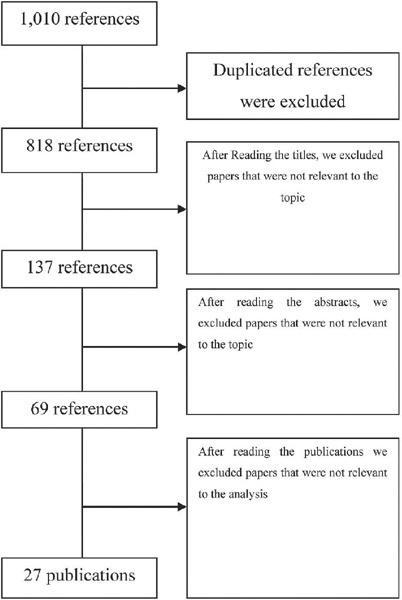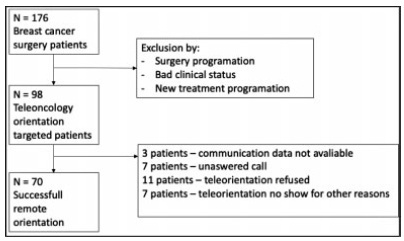Summary
Revista Brasileira de Ginecologia e Obstetrícia. 2023;45(3):149-159
07-10-2023
This article aims to review the literature regarding the use of technologies to promote mental health for pregnant women. We seek to: understand the strategies that pregnant women use for mental health care. Also, we investigate the existence of scientific evidence that validates such practices.
This study follows the PRISMA guidelines for systematic reviews. We analyze 27 studies published between 2012 and 2019. We include publications in Portuguese, English, and Spanish.
The results revealed several different possibilities to use technology, including the use of text messages and mobile applications on smartphones. Mobile applications are the most commonly used approaches (22.5%). Regarding the strategies used, cognitive-behavioral approaches, including mood checks, relaxation exercises, and psychoeducation comprised 44.12% of the content.
There is a need for further investigation and research and development efforts in this field to better understand the possibilities of intervention in mental health in the digital age.

Summary
Revista Brasileira de Ginecologia e Obstetrícia. 2023;45(4):179-185
06-30-2023
We describe the development and structure of a novel mobile application in a mixed model of prenatal care, in the context of the COVID-19 pandemic. Furthermore, we assess the acceptability of this mobile app in a cohort of patients.
First, we introduced a mixed model of prenatal care; second, we developed a comprehensive, computer-based clinical record to support our system. Lastly, we built a novel mobile app as a tool for prenatal care. We used Flutter Software version 2.2 to build the app for Android and iOS smartphones. A cross-sectional study was carried out to assess the acceptability of the app.
A mobile app was also built with the main attribute of being connected in real-time with the computer-based clinical records. The app screens detail information about activities programmed and developed in the prenatal care according to gestational age. A downloadable maternity book is available and some screens show warning signs and symptoms of pregnancy. The acceptability assessment was mostly rated positively regarding the characteristics of the mobile app, by 50 patients.
This novel mobile app was developed as a tool among pregnant patients to increase the information available about their pregnancies in the provision of a mixed model of prenatal care in the context of the COVID-19 pandemic. It was fully customized to the needs of our users following the local protocols. The introduction of this novel mobile app was highly accepted by the patients.
Summary
Revista Brasileira de Ginecologia e Obstetrícia. 2022;44(9):845-853
07-19-2022
To develop a protocol for hybrid low-risk prenatal care adapted to Brazilian guidelines, merging reduced face-to-face consultations and remote monitoring.
The PubMed, Embase, and Cochrane Library databases were systematically searched on telemedicine and antenatal care perspectives and adaptation of the low-risk prenatal care protocols recommended by the Ministry of Health and by the Brazilian Federation of Gynecology and Obstetrics Associations.
Five relevant articles and three manuals were included in the review, for presented criteria to develop this clinical guideline. We identified, in these studies, that the schedule of consultations is unevenly distributed among the gestational trimesters, and ranges from 7 to 14 appointments. In general, the authors propose one to two appointments in the first trimester, two to three appointments in the second trimester, and two to six appointments in the third trimester. Only three studies included puerperal evaluations. The routine exams recommended show minimal variations among authors. To date, there are no validated Brazilian protocols for prenatal care by telemedicine. The included studies showed that pregnant women were satisfied with this form of care, and the outcomes of interest, except for hypertensive diseases, were similar between the groups exposed to traditional and hybrid prenatal care.
The presented guideline comprises the Ministry of Health recommendations for low-risk prenatal care and reduces exposure to the hospital environment and care costs. A randomized clinical trial, to be developed by this group, will provide real-world data on safety, effectiveness, satisfaction, and costs.
Summary
Revista Brasileira de Ginecologia e Obstetrícia. 2021;43(11):840-846
01-12-2021
The present study aims to assess the feasibility and patient satisfaction of teleoncology orientation in a vulnerable population of breast cancer patients assessed in a government health system during the coronavirus pandemic in 2020.
Eligible patients received an invitation to receive remote care to minimize exposure to an environment in which the risk of respiratory infection was present. The means of communication was telephone through an application that allows free conversation with no charge. An anonymous-response questionnaire based on a Likert-type scale was sent through a cell phone application or e-mail directly to each patient or close relative of the patient immediately after teleconsultation. Responses to the questions, which addressed utility, facility, interface quality, interaction quality, reliability, satisfaction, and interest in future evaluation, were compiled and analyzed.
A total of 176 eligible patients scheduled for consultation were evaluated and 98 were included. Seventy (71.4%) successfully undertook the teleorientation. The questionnaire was submitted by 43 (61.4%) patients. The overall teleoncology orientation was classified as very positive by 41 (95.3%) patients. Specifically, regarding the questionnaire items, 43 (100%) patients scored 4 or 5 (agreed that the teleconsultation was beneficial) concerning the facility, followed by 42 (97.2%) for the interface quality, 41 (95.3%) for both utility and interaction quality, 40 (93%) for satisfaction and interest in future evaluation, and, finally, 39 (90.6%) for reliability.
Teleoncology orientation of low-income breast cancer patients is most feasible and leads to high patient satisfaction.
